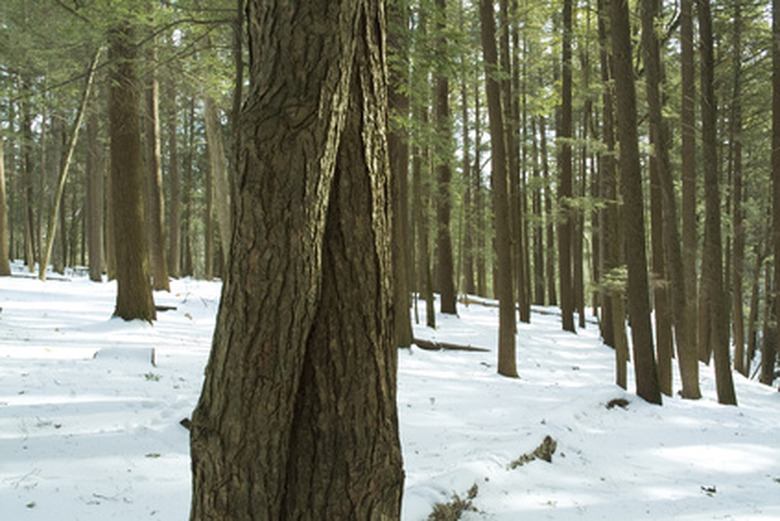Root System Of Hemlock Trees
Hemlock trees belong primarily to the Tsuga genus. Some species, such as water hemlock (Cicuta maculata), are not actually related to the hemlock (Tsuga) genus. Water hemlock is from a different genus and family. It only shares a common name with species like western hemlock. Species of hemlock have both standard types of root systems and affect the landscape in different ways.
Root System Types
Though the various species of hemlock have a number of different root system types, the two most common are taproot and fibrous roots. In taproot systems a large central root grows straight into the soil in search of water and nutrients. The taproot digs deep and is thicker than the small roots surrounding it. These small roots branch laterally in the soil. Small roots also grow directly from the taproot. Fibrous root systems do not have taproot. Rather, they comprise a tangle of equally sized roots growing laterally and vertically in the soil. Fibrous roots grow from any part of a plant placed in the soil. Taproots will not do this.
Root System Impact
A number of hemlock species with fibrous roots possess shallow root systems. Eastern or Canadian hemlock (Tsuga Canadensis), a common landscaping species, has a shallow but aggressive root system. These roots take advantage of garden or landscape areas by spreading quickly and usurping nutrients intended for other species. Because of this, species planted near Canadian hemlock require extra care. Western hemlock (Tsuga heterophylla) has similarly shallow, very fine roots commonly damaged by farming or gardening equipment and fire.
Carolina hemlock (Tsuga caroliniana) is a taproot species. Because taproots grow vertically they do not promote competition with other plants unless multiple specimens with large taproots are pitted against one another.
Toxicity
Roots on some hemlock species are noted for their toxicity. According to Texas A&M University, two species in particular are noted for their toxicity: water hemlock and poison hemlock (Conium maculatum). Interestingly, neither one of these plants is a true hemlock of the Tsuga genus, despite hemlock being associated with its poisonous qualities. Socrates, for instance, drank hemlock as a means of committed suicide. In fact, no true hemlock species is poisonous.
The ingestion of water or poison hemlock roots, leaves, stems and more leads to painful, violent convulsions and, in many cases, death. According to Colorado State University veterinarian Anthony Knight, one or two ounces of hemlock kills an adult horse.
Propagation
Fibrous root system plants propagate from cuttings. This entails taking a hardwood or semi-hardwood cutting of a living specimen and planting it. If properly nurtured, the planted cutting grows roots and turns into a new specimen. Washington State University professors FE Larsen and We Guse warn that while this is possible with species of hemlock it is also very difficult.
In their natural environment, hemlock roots grow from seed. Hemlocks are gymnosperms, or cone-bearing species. Fertilized seeds fall with cones or are dropped by birds. Seeds germinate in fertile soil, growing root systems.
Taproot species cannot propagate via cuttings. They only grow from seed.
